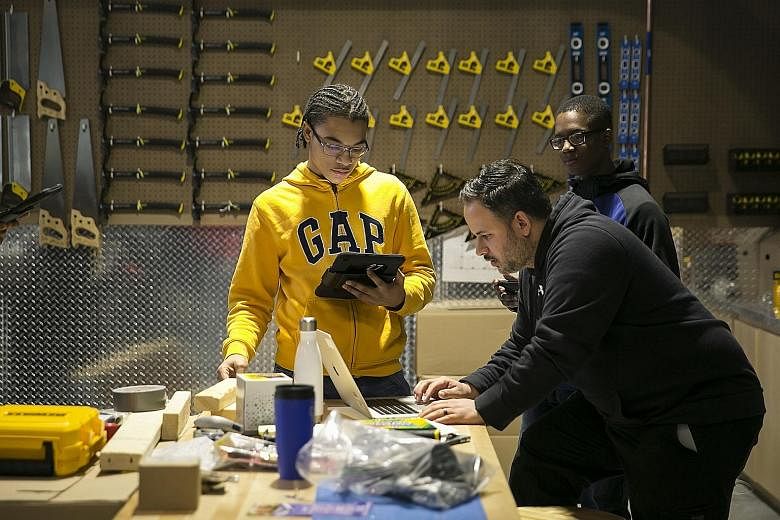NEW YORK • They brainstorm in conference rooms equipped with whiteboards, use high-end computers and equipment and are given free breakfast and lunch.
Except these are no start-up workers. They are students at an unusual New York City public high school embedded inside a technology and manufacturing hub with more than 400 companies at the Brooklyn Navy Yard.
It was developed with industry leaders to teach real-life job skills that would lay the foundation for the next generation of workers in a city where the tech industry is flourishing with the expanding presence of Google and Amazon's plans to build a large campus in Queens.
While classrooms in New York and elsewhere have increasingly focused on preparing children for jobs in a tech economy, the recently opened school, Brooklyn Steam Centre, has taken it one step further by locating itself next to companies where students might actually work. It is one of only a handful of programmes in the United States that are situated in a workplace.
"Our ambition is that it will be a next-generation model for career and technical schools here in New York City," said Mr David Ehrenberg, president and chief executive officer of the Brooklyn Navy Yard Development, a non-profit that manages the city-owned, 121 ha waterfront site where battleships, like the USS Missouri, were once built.
The Navy Yard already has an on-site job centre, but Mr Ehrenberg said the school will help ensure that more local residents have the necessary technical skills and training for the jobs being created there.
The programme offers students a chance to show what they can do.
"Instead of learning on paper - and maybe you forget it, and maybe you don't - you put your hands into the work," Jordan Gomes, 16, said.
Yesterday, the schools chancellor, Mr Richard Carranza, and other city leaders officially opened the school's US$17 million (S$23.1 million) home at the Navy Yard, about two weeks after students moved in.
The Steam Centre - standing for science, technology, engineering, arts and mathematics - grew out of a pilot programme to increase career and technical education opportunities among Brooklyn high school students.
Today, 221 juniors and seniors spend half the day at other high schools taking required academic classes and the other half at the centre specialising in one of five tracks: design and engineering; computer science and information technology; film and media; construction technology; and culinary arts and hospitality management.
The students apply to the centre and are selected by their high schools. There is no minimum required grade-point average or test score.
In New York, the Steam Centre is one of only two schools at a workplace; the other, Aviation High School, offers classes at LaGuardia Airport.
"We're certainly looking for more opportunities for our students to be as close to the industries they are studying as possible," said Mr Phil Weinberg, the Education Department's deputy chief academic officer for teaching and learning.
Citywide, there are 301 career and technical programmes - 47 opened in the past three years. In total, the programmes enrol about 64,000 students and train them for careers ranging from software engineer to harbour master.
Still, some educators and parents have raised concerns that such highly specialised programmes are a form of tracking that can lead students to focus too early on a particular job or career and be steered away from college.
Mr David C. Bloomfield, a professor of educational leadership, law and policy at Brooklyn College and the CUNY Graduate Centre, said the Steam Centre needed to be thoroughly vetted by parents, independent industry experts and college representatives to ensure that it puts the needs of students over employers.
"There's a danger that it's either a self-serving track for low-skilled jobs right out of high school, or that it teaches skills that will be obsolete once they complete college," he said.
The Steam Centre was developed by Mr Kayon Pryce, the founding principal, along with Mr Ehrenberg and Dr Lester W. Young Jr, a member of the state Board of Regents and a former city education official. It initially held classes in two high schools before moving to the Navy Yard.
The emphasis at the school is on being relevant in a modern tech world. Students master design, engineering and construction skills by transforming two shipping containers into smart homes. Computer science students wired the new computer lab; now they maintain the network and troubleshoot problems. Film and media students recorded podcasts, and shot and edited a commercial promoting the school.
The school also teaches soft skills - or what Mr Pryce calls "21stcentury success skills" - such as the importance of showing up on time, responding to e-mail and getting along with co-workers. Students also learn to network, coming up with a 30-second "elevator pitch" - the time it takes to ride the elevator up to the centre's home on the third floor.
Deon Watts, 16, said the lessons would not only help her succeed in a male-dominated construction industry, but also assist her in becoming the boss of her own company.
"It's not like your English class can teach you how to build a box or fix an electrical circuit," she said. "It's important because that's how you're going to survive in the real world. It's not as easy as reading a book."
NYTIMES

